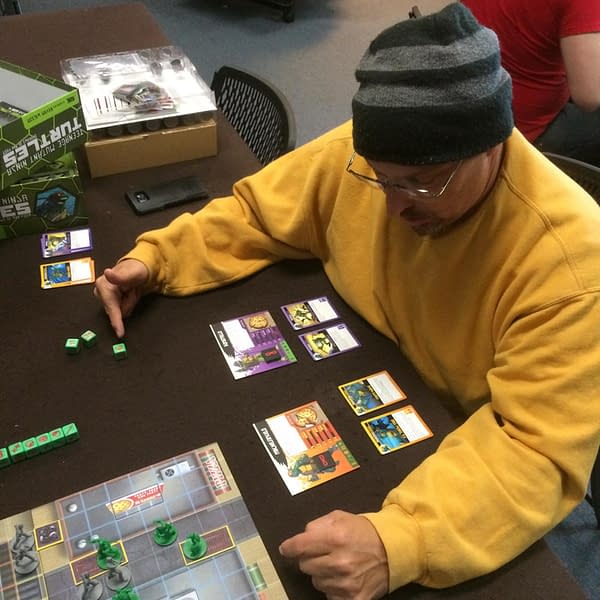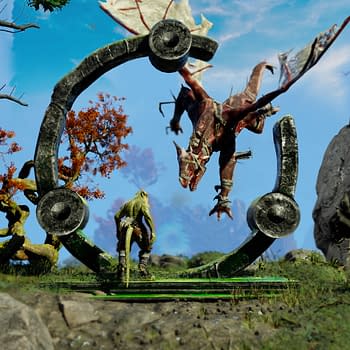Posted in: Board Games, Games, Review | Tagged: idw, idw games, Shadows of the Past, teenage mutant ninja turtles, Teenage Mutant Ninja Turtles: Shadows of the Past, tmnt
Flipping Through Mutated Battle Pages Of 'Teenage Mutant Ninja Turtles: Shadows of the Past'
I grew up a Ninja Turtles fan, though my time with the series started like most fans did with the '80s cartoon show that would pop up every Saturday morning. I also had an impressive collection of action figures from the show, because back then they were cheap as hell for $1.50 at K-Mart. Back then we all wanted to fight with the Turtles and Master Splinter, battling the Foot Clan and Shredder, but the best we got were badly designed board games that made you fight for pieces of pizza. Rough times. Flash forward to modern day where adult me now gets to see the series blossom again with awesome stuff, including the latest board game from IDW Games, Teenage Mutant Ninja Turtles: Shadows Of The Past.
Originally a Kickstarter game that received triple it's funding and then some, Shadows Of The Past is a scenario-driven campaign game that utilizes the same kind of gameplay as titles like Zombicide, but with different mechanics. The game is based off the current run of TMNT that IDW is producing, but the adventure inside is a stand-alone adventure that doesn't tie directly into the series or requires a ton of reading outside of the game. If you know the Turtles and their villains, you're good to go.
For this review, we received the standard edition of the game, no bonus content or additional characters that came out later. The game comes with two adventure comics, a rulebook, a bonus comic about the story you're playing, punchout cards with everything you need, battle dice, map squares, information and deck cards, and two rows worth of plastic action figures. The figures themselves are well done—not super refined in microscopic detail, but not bland generic pieces either. They're very middle-of-the-road in design so that you can see who everyone is and paint them up if you desire, which I would highly recommend for the artists out there who have wanted to paint TMNT figures.
The game itself is complex to learn—the rules have been watered down as much as they can be into 20 pages, as opposed to others of this genre which can get up to 60 pages of explanation. But that doesn't mean the game is a breeze to play as you'll need to read up on what everything does before you dive in. That was probably my only real problem with the game is that myself and other groups who played it kept making Beetlejuice jokes that it "read like stereo instructions." Everything you needed to do would send you to another page rather than explaining it in a regular fashion, so putting the pieces together of how to play required a lot of reading and a lot of time to understand it with a playthrough.
For this particular game you're seeing in photos, my friend Tony and I headed over to Demolition Games in Salt Lake City to try it out and get a public opinion over the game itself. The game is for 2-5 players with at least one person acting as the villains and the rest acting as the Turtles. Using the adventure comics given to you, you'll lay out the maps, terrain, figures and other information needed to play each chapter of the book. Once an adventure is completed, win or lose, the Turtles move onto a new battle once it is completed.
Each of the Turtles is given a character card and a set of special abilities to choose from, and they will roll their specific dice to determine their actions. Since the Turtles act as a team, some of the dice can be shared by other members of your party, depending on how you line yourselves up on the table. The villains work an entirely different system using a deck of cards, with their abilities and attributes determined by who is on the board and what you draw for them to do. It gives the game a slight edge of competition as there's clearly one person with one goal in mind (as opposed to random encounters made by the game), while anyone else has to work as a team to overcome the odds.
As you fight with each other in Shadows Of The Past, the Turtles all receive one turn a piece with the villains being able to fight back after each one has played. You can choose the order in which the Turtles fight each round, but ultimately you will need to rely on what you rolled, how you positioned it, who you're working with to give extra dice help to, and how you intend to vanquish enemies you encounter. It becomes very easy for gun-ho players to lose objectivity and go wild on a single enemy, leaving themselves open for attack. Especially anyone playing Raphael as his character tends to act more as a loner compared to the rest of the group in play, no matter who plays as him.
Often times your real enemies are the terrain you battle in. Depending on what's placed on the map, certain areas and objects have colored borders around them with corresponding cards to tell you what each terrain does and how it affects gameplay. Often times you'll find yourselves in weird positions, like being on top of a building and needing to get down a fire escape, which will burn a lot of your movement rolls just to make it to ground level. Other timers you'll have objects like garbage in your way or cars you'll need to jump over in order to get to your target, depending on how well the villain player is moving and fighting you.
Your other enemy will often be the dice, both for the Turtles and for the combat. When you roll the green dice for your Turtles, you're given options of how to arrange them so other players can use them. If you don't like them, there are options to reroll, but you're stuck with whatever you get after the reroll. When you hit combat everything is basically luck of the roll. You can find ways to put more dice in your hand and gain advantages, but sometimes you just can't beat a poor roll. Every Turtle comes with special abilities that use health, focus, movement and skill to pull off that can do massive amounts of damage if done correctly, and often times become the point where the battle shifts into the hero's favor.
At the end of every fight, there are two scenarios in the comics: What happens if the Turtles win and what happens if the villains win. Often it will tell you that you screwed up royally and will skip a chapter where you might learn more information or be able to gain better abilities to fight with. Sometimes it will tell you that you lost this round at the Shredder made off with whatever he was planning to do. But with the exception of all the Turtles dying, the comic always progresses. Which means the end of a battle isn't the end of the story, and that gives the game great replay value as you can continue on from where you left off another day, even in defeat.
Teenage Mutant Ninja Turtles: Shadows Of The Past is a fine game and well worth it for anyone into these bigger strategy battle titles to check out. There's a lot to learn and sometimes it can be confusing, but once you play for a while and work out all the kinks, the game is amazing to play. I personally would love to get all the expansions and try them out to see how well the battle goes with April O'Neil and Casey Jones on my side as we battle Bebop and Rocksteady. Playtime is a bit lengthy, but that's the way it is with any of these adventure titles, so keep that in mind that you'll want to set a couple hours or even an entire day aside to get in some great battles. I highly recommend checking it out and playing it with fellow fans of the series so you won't need to explain why four turtles are fighting a human can opener.



















